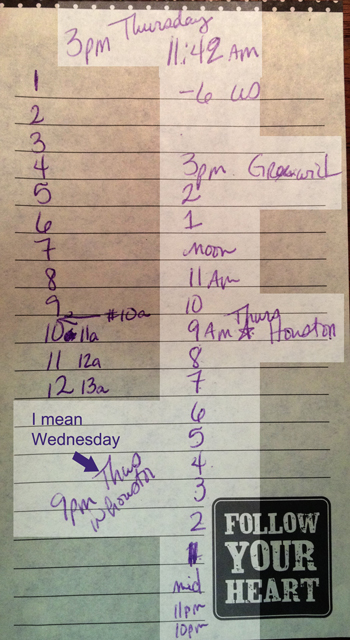It took me a long time to learn how to figure out what time it was in Los Angeles when it was at 7 AM in Houston.
Notice on this time zone map that the numbers count in a very intuitive way across the US:
 This works just fine if you’re managing locally.
This works just fine if you’re managing locally.
Global time zones are more of a challenge.
Many of you get the weekly Someday? Monday! newsletter that I send out. Generally it should arrive in your inbox between 3 PM and 6 PM Thursdays – in your local time zone.
Which means any changes that I had to do must happen before you get the e-mail at 3pm on Thursday.
But not everybody lives in Texas. So my deadline is not 3 PM on Thursday, really. It’s the first time anyone in the world encounters 3 PM Thursday.
In order for me to make the deadline for a global audience, it was essential to figure out what time in Houston that is.
Greenwich Mean Time -6
According to the website Greenwich Mean Time:
Greenwich Mean Time (GMT) was established in 1884 at the International Meridian Conference, when it was decided to place the Prime Meridian at Greenwich, England.
All time zones range from GMT -12 hours GMT +12 hours. Houston is Greenwich Mean Time -6 hours. Which means it should be a rather easy exercise.
All I have to do is add my six hours on the left side of the Meridian to the 12 hours on the right side to see that I’m 18 hours difference.
I subtract 18 hours from 3 PM Thursday to arrive at 9 PM Wednesday as my true deadline.
But we all know what happens when you say, “all you have to do is.”
I used maps, charts and a lot of time.
As I mentioned in the discussion of the book What Your Math Problem?, I often use very crude methods to solve problems.
I opened up a world time zone map, started counting and making charts:
I didn’t solve the problem traditionally.
Often when grownups present math problems to kids, they’ve prepared. They demonstrate working a problem like I worked it above:
Add my six hours on the negative side of Greenwich Mean Time to the 12 hours on the positive side. I’m 18 hours difference. Subtract 18 hours from 3 PM Thursday to arrive at 9 PM Wednesday as my true deadline.
But that’s not the real way we do math. We often use the Fret & Grind method. Fret about what’s going on, grind out some rough sketches. Then fret some more…
So why do we show kids the nice way?
If they see the “all you have to do is” way, then they won’t gain the confidence to use the Fret & Grind method.
And the Fret & Grind method is the best way – sometime the only way.
How do you teach time zone math? Do you encourage Fret & Grind?
You might also like:
- What’s Your Math Problem? Book Study
- 1 Word to Eliminate from Your Teaching Vocabulary
- 7 Ways to Wrangle a Word Problem
- How to Free Your Students from Math Anger
This post may contain affiliate links. When you use them, you support us so we can continue to provide free content!










